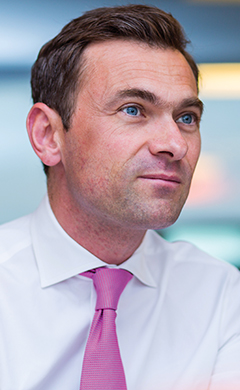Dutch bank ING is proud of its track record in innovating to improve the lives of its customers, as its chief innovation officer, Benoît Legrand, outlines to Joy Macknight.
ING’s innovation strategy supports the bank’s overall mission of delivering value to customers, according to Benoît Legrand, ING’s chief innovation officer and CEO of ING Ventures, a €300m fund that invests in fintech companies around the world. “We want to empower customers to stay ahead in life and in business, and everything we do in innovation should serve that goal,” he says.
The innovation team also has what Mr Legrand calls “beyond banking” priorities, effectively to push the boundaries of what is defined as a bank today. He points to Yolt, the smart money app that ING spun up to aggregate account data. “Through Yolt, we can analyse the data to better understand our customers and provide insights into the way they are managing their money,” he says.
Career history: Benoît Legrand
- 2018 ING, chief innovation officer
- 2017 ING Ventures, CEO
- 2015 ING, global head of fintech
- 2012 ING Bank France, CEO
“Customers are looking for ways to take greater control of their financial lives,” he adds. “The power is shifting away from the almighty institution dictating the way customers bank, to a world where digitisation is allowing customers to have more say over how and when they access financial services.”
Forging connections
Mr Legrand summarises ING’s innovation strategy as three Cs: customers, culture and connections. “We solve the problems of our customers and make their lives easier. We highlight culture because it is ultimately about people, not just about technology. And, lastly, connections, because while we have many smart people in ING, there are many more outside of ING that we want to connect with,” he says.
Today ING is working with 190 fintechs and has invested more than €200m in 25 start-ups through its venture capital arm. For example, in April 2019 it led a €19m funding round in Spanish fintech Fintonic, which plays a similar role to Yolt; and in September 2018 it invested €7.5m in Dutch start-up Cobase, which helps corporate treasurers aggregate account and reporting data.
“We are trying to open up and build platforms to ensure we aren’t isolated,” says Mr Legrand. “We firmly believe that the linear model of banking – where we build a product, sell it and then do the aftersales service and maintenance – is gone. We are now building an ecosystem in which we are at the centre of the customer relationship and we are connecting them to the best services for them.”
Reaping results
The bank’s strategy has progressed to what Mr Legrand dubs “Innovation 3.0”. The first stage was to put innovation on the bank’s agenda. The second stage was about actively engaging and getting the wider workforce involved through bootcamps and hackathons. “Now we have moved to a stage where we want to have impact, so it is less about quantity and more about the quality of our activities,” he says. “We might do a bit less, but we are looking for greater effect.”
He considers Yolt, which launched in 2017 in the UK and is about to reach the 1 millionth-customer milestone, to be one of ING’s biggest successes in the new ecosystem world. “While other banks might have seen open banking as a threat, we have seen it as an opportunity to better serve customers,” he says.
ING Ventures is the second success story, according to Mr Legrand, because it shows how the bank is building optionality, testing things outside of ING and potentially helping these new ideas become more successful. For example, the bank has recently identified six to eight potentially scaleable fintechs. “If we get two or three of them to scale, then that will be a major breakthrough,” he says.
ING is also implementing innovative ideas such as invisible payments. For example, the bank is working with Nederlandse Spoorwegen, the Dutch railway, to eliminate the need for cards, turnstiles and tickets in public transport. “It is fantastic for the user because they don’t need a ticket and good for the railways because they can get rid of infrastructure and have a better price point because they have much more accurate data on their customers,” he says.
Future possibilities
Mr Legrand is reticent to predict the future of banking; however, he envisages the disappearance of devices over the next 10 years. “We will be moving into ‘bionic banking’ where human beings might be equipped with chips. Speech will become the leading channel for communicating with the bank, with virtual but nearly human assistants managing your money. Why do I believe this? Because this is a continuation of the trend of making people’s lives easier,” he says.
But the role of human intervention in the customer relationship will not completely vanish, he adds. “While there is a lot we can digitise, I also predict a hyper-humanisation of financial services, where the need for strong human, respectful touch will be essential,” says Mr Legrand. “As we risk being dehumanised by technology and digitalisation, a bank can make a difference by humanising even more.”



